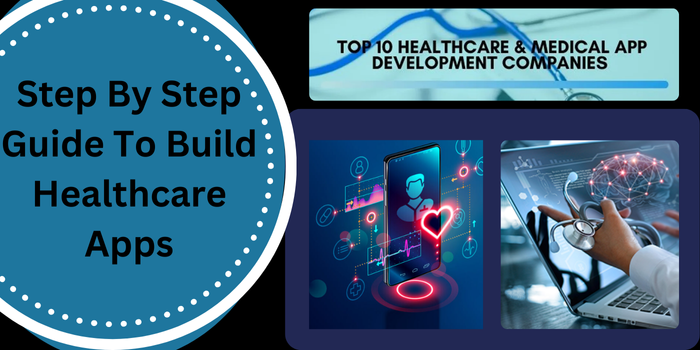Guide To Building Healthcare Apps
In the trendy digital age, the demand for healthcare apps is skyrocketing, revolutionizing how people get admission to medical offerings. Building a healthcare app requires a meticulous step-by-step approach to ensure capability, safety, and person-friendliness.
From conceptualization to deployment, every stage performs a crucial function in creating an effective app that meets customers’ needs. Whether it’s facilitating far-off consultations, tracking health metrics, or locating plasma near me, a complete guide can streamline the improvement system and ensure the success of healthcare apps in improving patient care and accessibility.
What Are the critical concerns at some stage in The planning stage?
In the strategy planning stage of healthcare app development, numerous key considerations are critical for fulfillment. First, the target audience’s perception and unique needs are paramount.
Knowledge of market tendencies and consumer alternatives allows one to tailor the app’s features. Secondly, compliance with healthcare rules, such as HIPAA, ensures that the affected person’s records are secure and private.
Moreover, defining clear objectives and desires for the app facilitates green development and deployment strategies. Establishing partnerships or collaborations with relevant healthcare companies, including CSL plasma, can beautify the app’s credibility and value by incorporating actual-time data and offerings.
What Features Should Be Prioritized For User Interface Design?
When designing the person interface for healthcare apps, prioritizing certain functions can enhance a person’s enjoyment and value:
- Intuitive Navigation: Make it exceptionally smooth to get the right of entry to quintessential features like appointment scheduling and clinical facts.
- Clean conversation: Use clear and concise language to convey statistics and commands efficaciously.
- Accessibility: Make the app handy to users of all skills by incorporating features like adjustable font sizes and voice navigation.
- Data Visualization: Present fitness facts and developments in visually appealing, clean-to-recognized codecs.
- Personalization: Allows customers to customize settings and preferences to fit their desires.
- Safety: Put in force robust safety features to shield sensitive personal information.
Prioritizing those functions can contribute to the growth of many of the best healthcare apps, offering patients a healthcare experience that is continuing and consumer-friendly.
How Do You Handle Feedback And Iterate On The App Post-Launch?
After launching a healthcare app, dealing with feedback is essential for continuous improvement. Set up channels for customers to give feedback, in-app surveys, or contact bureaucracy. Examine remarks often and prioritize areas for improvement primarily based on consumer pointers and ache points.
Iterate on the app by enforcing updates and enhancements to address remarks and beautify those who revel in them. This iterative process guarantees that the app evolves to fulfill customers’ needs, contributing to its popularity as one of the best healthcare apps.
What Steps Are Involved In Testing The App For Usability And Security?
- Usability testing: A behavior person is trying out with a people consultant of the target audience to assess the app’s ease of use and navigation.
- Acquire remarks on user interface sketches, characteristic accessibility, and typical user enjoyment.
- Iterate the app based on user comments to improve usability and optimize workflows.
- Protection checking out: Perform penetration testing to identify the app’s infrastructure and records storage vulnerabilities.
- Put into effect encryption protocols to guard touchy patient information.
- Regularly replace security features to guard against evolving threats.
- Through rigorously testing for usability and protection, builders can ensure that their healthcare app meets excessive standards of first-class and reliability, positioning it as one of the best healthcare apps available.
What Resources Or Tools Are Recommended For Healthcare App Development?
Several sources and equipment are encouraged for healthcare app development:
- Frameworks: Utilize frameworks like React Native or Flutter for go-platform development, streamlining the method and lowering development time.
- APIs: Integrate healthcare APIs, including FHIR (speedy Healthcare Interoperability sources), for seamless admission to electronic fitness information and interoperability with healthcare systems.
- Diagram tools: Appoint sketch gear like a graph or Adobe XD to create intuitive consumer interfaces that enhance a person’s revel in the best healthcare apps.
- Protection Libraries: Put security libraries like OWASP (Open Web Utility Security Challenge) in force for robust protection in opposition to unusual vulnerabilities.
By leveraging these resources and tools, developers can create the best healthcare apps that meet user wishes and industry requirements.
What Programming Languages Are Commonly Used To Build Healthcare Apps?
Popular languages include Java, quick, and Kotlin for cell apps, while Python and JavaScript are commonplace for internet-primarily based packages. Deciding on the proper language depends on platform compatibility and developer expertise.
What Are The Essential Features To Include In Healthcare Apps?
Essential functions include appointment scheduling, tightly closed messaging for communication with healthcare companies, integration with digital fitness statistics (EHRs), remedy reminders, and health tracking functionalities. Those functions beautify user engagement and streamline healthcare strategies.
How Can Healthcare App Developers Ensure User Privacy And Data Security?
Builders must prioritize facts encryption, invulnerable authentication techniques, and regular safety audits. Additionally, acquiring explicit user consent for statistics collection and ensuring transparent privacy rules fosters faith amongst customers. Regular updates and patches are quintessential to addressing rising security threats.
















